Fynbos Country
This is fynbos country - the last sliver of a fire-adapted, shrubby veld before the land gives way to the near-desert succulent Karoo. It is the most arid type of fynbos and good for just about nothing in the commercial farming sense.
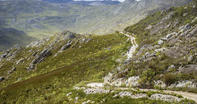
Except for tea. In a century, rooibos has grown from being the poor man's cha to one of the most sought-after health teas in Europe, North America and Japan. And the Suid Bokkeveld has it growing wild. Oompie Hen is chairman of the Heiveld Cooperative, a group that has grown to just over 40 sharecroppers who, in 2001, broke into the swelling rooibos market. Most of their tea is cultivated but they also pick through the natural veld for rare wild rooibos.
Their individual contributions remain small - some may only have three or four bags of rooibos to sell each season, amounting to less than 200 Kg of crop. The total 2007 harvest for the Heiveld Cooperative was 60 tons - a fraction of what a single commercial farm might produce. Many commercial operations will sell 200 tons or more of the stuff each year and even then it is usually just one of several crops grown on the farm.
Exporting to Premium-priced Market
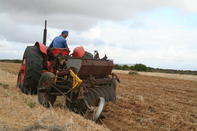
The Heiveld Cooperative is exporting its crop to markets where people happily spend their money on premium-priced organic, Fair Trade and wild tea. And the community's fortune is changing. All the co-operative members have their first bank accounts. One person had a set of dentures made; another took a family member to hospital for treatment - both healthcare "luxuries".
These are quiet signals that a community, whose education often does not extend beyond grade four, is dipping its toe into a viable mainstream market. The Hesselmans' operation now sports a second-hand tractor and trailer - paid for with cash - and a small, if slightly weathered, 2x4 bakkie. This means they can bring their supplies to Dobbelaarskop by vehicle from nearby Nieuwoudtville, if they have the cash to afford fuel that month, instead of hauling it in on their backs or by bicycle or donkey cart.
Desperately poor and mostly illiterate, Oompie Hen would probably never have believed that he might one day become a landowner, but rooibos may be his ticket to gaining that one thing that has evaded his family - a title deed. Except that shifting long-term weather trends might put an end to this dream.
No Running Water
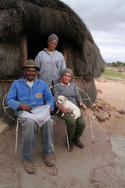
The Dobbelaarskop homestead is a cluster of small buildings - some reed and mud constructions, others brick. There is no electricity out here, this far from the national grid. A telephone line was only recently strung up in the late 1990s. They have no running water, since the farm's groundwater is too deep to extract using borehole and windmill, and they're too remote from anywhere to have municipal water piped in.
Since his parents settled here in 1960, they have depended on a nearby spring which filters through sand and bedrock before spilling into a catchment from where they collect it in buckets for cooking, cleaning, drinking and watering their livestock. Only now, after four years of drought, the spring has withered to little more than a muddy drink.
They've had to haul water in, in tanks, by bakkie - and if there's no cash for fuel, it's back to the donkey cart. One neighbour refused access to a water course because he didn't want anyone other than himself on the property. The Dobbelaarskop spring is something of a symbol of the tremendous irony that is the global climate crisis.
Intense Drought
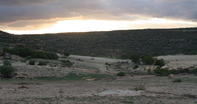
No one can own the atmosphere, the oceans or the water cycle. But these can still be messed up. And for the Hesselmans, this could spell the end of their early foray into the world of tea exports. Although natural drought cycles are written into the farm's history, this one is bad, and it's a harbinger of things to come.
Already, weather records going back four decades suggest the temperature has risen in these parts by about 1°C. Inexplicably, this is double the average increase over the rest of the country and the rise is expected to continue, accompanied by increasingly frequent and intense drought and slackening rainfall. Wind speed is higher, on average, by as much at 3 km per hour, which drives evaporation and dries out soils.
The winter storm tracks which bring the region's rain are increasingly pushing south, missing the continent and dumping their water out at sea. These trends will continue, which many farmers are steeling themselves against, since they know the microclimates on their farms cannot support another 2°C increase in temperature which is already guaranteed to occur in the next 50 years.
Desert Pressing South
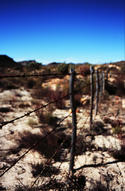
Scientists theorise that species, and the climatic envelopes in which they live, will shift towards the poles as increasing atmospheric carbon dioxide pushes up temperatures globally. Then, in the late 1990s, researchers from the South African National Biodiversity Institute (SANBI) were sent out into Namibia to investigate the mysterious and widespread deaths of quiver trees.
They surveyed across the full natural range of the tree from near the rooibos farms of Nieuwoudtville to the Brandberg Mountains in north-east Namibia, and discovered that the trees were dying in the north but thriving in the south. This confirms what the climate models are predicting, that the desert will press south, sweeping aside species as it goes. Worse still, it appears to have been doing so for decades, and the rooibos plantations of the Suid Bokkeveld are directly in its pathway.
Adapting Farming Methods
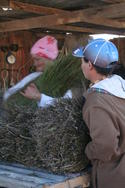
Oompie Hen is not ignorant of the looming cloud of global warming, threatening a hotter, drier future. But for today, he is content, because the rains finally came in May. "I don't have much," says the old man, his body swaying minutely to the measured ambulations of the bakkie as it picks its way down the weathered farm road, "but what I have, I'm grateful for."
The young man who took over the Dobbelaarskop farm after his father’s passing in 1961 would probably never have guessed that he might one day own a piece of land. But now Henrik Hesselman would like the one thing that has evaded his family all these years – a title deed. He would like to pass his rooibos interests over to his youngest son, Bennet, and hopes that this legacy will include the land they have lived on for four decades.
The recent success of the Heiveld Cooperative, through their rooibos exports, might be his ticket to becoming a landowner, if they can survive the increasingly severe droughts, rising temperatures and more erratic rainfall that is expected to hit the region. Already the community is adapting its farming methods in an effort to stave off the creeping desert.
Farmers protect soil moisture by mulching the land, they plant buffer stripes and windbreaks between plantations using the reeds and shrubs which occur naturally in fynbos, they drop reeds in a hatch-work pattern to protect the soils which would otherwise be reduced to shallow dune-like fields as soon as the plough is put through and the natural vegetation removed.
By Leonie Joubert